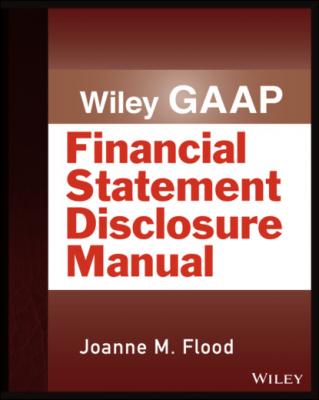Wiley GAAP: Financial Statement Disclosure Manual. Joanne M. Flood
Читать онлайн.| Название | Wiley GAAP: Financial Statement Disclosure Manual |
|---|---|
| Автор произведения | Joanne M. Flood |
| Жанр | Бухучет, налогообложение, аудит |
| Серия | |
| Издательство | Бухучет, налогообложение, аудит |
| Год выпуска | 0 |
| isbn | 9781119365723 |
3 Disclosure and Presentation Requirements ASC 210‐10, Overall Assets Liabilities Stockholders' Equity Form of the Statement of Financial Position ASC 210‐20, Offsetting Presentation Disclosures
4 Presentation and Disclosure Examples Example 3.1: Statement of Financial Position—Highly Aggregated Example 3.2: Statement of Financial Position—Highly Detailed Example 3.3: Disclosure by Type of Financial Instrument Example 3.4: Disclosure by Type of Financial Instrument and Type of Counterparty Example 3.5: Sophisticated Entity Disclosure by Type of Financial Instrument and Type of Counterparty Example 3.6: Netting of Certain Balance Sheet Accounts
AUTHORITATIVE LITERATURE
Statements of financial positions (also commonly known as balance sheets or statements of financial condition) present information about assets, liabilities, and owners' equity and their relationships to each other. They reflect an entity's resources (assets) and its financing structure (liabilities and equity) in conformity with generally accepted accounting principles (GAAP). The statement of financial position reports the aggregate effect of transactions at a point in time, whereas the statements of income, retained earnings, comprehensive income, and cash flows all report the effect of transactions occurring during a specified period of time such as a month, quarter, or year.
It is common for the statement of financial position to be divided into classifications based on the length of the entity's operating cycle. Assets are classified as current if they are reasonably expected to be converted into cash, sold, or consumed either within one year or within one operating cycle, whichever is longer. Liabilities are classified as current if they are expected to be liquidated through the use of current assets or incurring other current liabilities. The excess or deficiency of current assets over or under current liabilities, which is referred to as networking capital, identifies, if positive, the relatively liquid portion of the entity's capital that is potentially available to serve as a buffer for meeting unexpected obligations arising within the ordinary operating cycle of the business.
Subtopics
ASC 210, Balance Sheet, is divided into two Subtopics:
ASC 210‐10, Overall, which focuses on the presentation of the balance sheet, particularly the operating cycle and the classification of current assets and liabilities, and
ASC 210‐20, Offsetting, which offers guidance on offsetting amounts for certain contracts and repurchase agreements accounted for as collateralized borrowings and reverse repurchase agreements accounted for as collateralized borrowings.
Scope and Scope Exceptions
ASC 210‐10 The guidance in ASC 210‐10 applies to all entities. However, the guidance related to classification of current assets and current liabilities does not apply if the entity does not present a classified balance sheet.
ASC 210‐20 The guidance in ASC 210‐20 does not apply to:
The derecognition or nonrecognition of assets and liabilities. Derecognition by sale of an asset or extinguishment of a liability results in removal of a recognized asset or liability and generally results in the recognition of gain or loss. Although conceptually different, offsetting that results in a net amount of zero and derecognition with no gain or loss are indistinguishable in their effects on the statement of financial position. Likewise, not recognizing assets and liabilities of the same amount in financial statements achieves similar reported results. (ASC 210‐10‐15‐2)
Generally, right of setoff involves only two parties. Exceptions to this two‐party principle are limited to the guidance in these Subtopics and paragraphs:
ASC 840‐30, paragraphs 32 through 52 (leveraged leases).
Upon implementation of ASU 2016‐02, Leases—ASC 842‐50 (leveraged leases).
ASC 715‐30 (accounting for pension plan assets and liabilities).
ASC 715‐60 (accounting for plan assets and liabilities).
ASC 740‐10 (net tax asset or liability amounts reported).
ASC 815, paragraphs 815‐10‐45‐1 through 45‐7 (derivative instruments with the right to reclaim cash collateral or the obligation to return cash collateral).
ASC 940‐320 (trade date accounting for trading portfolio positions) and 910‐405 (advances received on construction contracts).
ASC 942‐210‐45‐3A.(ASC 210‐20‐15‐3)
PRACTICE ALERT
Financial statement classification is a frequent topic of SEC comment letters. While SEC rules only apply to public entities, preparers of financial statements can benefit from the findings of SEC reviewers. The classifications of current and noncurrent assets and liabilities, including debt, have been a source of SEC staff comments. Preparers should look to the guidance in ASC 210‐10‐45 and the discussion in this chapter when preparing classified balance sheets to determine whether an item should be classified as current or noncurrent.
Another item that appears in SEC comments relates to the disaggregation of assets and liabilities. The SEC requires disclosure on the face of the financial statements or in the notes items in excess of 5% of total assets and total liabilities, respectively. Again, this is not required for non‐SEC filers, but may be a benchmark for preparers to consider when deciding which items to disaggregate.
DISCLOSURE AND PRESENTATION REQUIREMENTS
ASC 210‐10, Overall
Presenting one year of financial statements is acceptable under GAAP, but two years for nonpublic companies is desirable. It is common for the statement of financial position to be divided into classifications based on the length of the entity's operating cycle. Assets, liabilities, and shareholders' equity are separated in the statement of financial position so that important relationships can be shown and attention can be focused on significant subtotals. It is common for reporting entities to present the items in the order of liquidity.
Assets
Current Assets Current assets are cash and other assets that are reasonably expected to be realized in cash or sold or consumed during the normal operating cycle of the business (ASC 210‐10‐05‐4). When the
